Before I tell you about my outing to Fen Drayton here’s a short update on the forest sell off. After denying they are backtracking, the Government has said they may reduce the amount of forest they are getting rid of. Plans to lose 15% of the 258,000 hectares of publicly owned forest are on hold whilst the government ‘re-examine the criteria‘ for the sale. I’m hoping this is government style smoke-and-mirror speak for ‘we’re deciding whether we should proceed at all‘. Time will tell. I think any reexamination is good news and maybe a sufficiently loud public outcry will force the powers that be to sit up and take notice of the vox populi on this issue, and maybe a few others too.
I didn’t manage a wildlife post last week, other events overtook me including the weather, which was blowing a gale at the weekend so I was struggling to see anything through binoculars and photography was completely out the question! So apologies for the omission. There were a few highlights from last weekend though: in a tree in the middle of a field behind Abbey Farm north of Histon I saw a pair of kestrels copulating – which is a fairly unusual sight but it’s good to know the local kestrel population should be increasing this year. Further round towards the Girton road was a big mixed flock of around 50 starling, a similar number of redwing and around 200 fieldfare feeding on the ground and as I was counting these a little egret passed over. I’d been told by a dog walker a couple of weeks ago there was one in that area but this was the first time I’d seen it for myself. Egrets are a comparatively recent addition to the fauna in the UK and they are slowly finding their way northwards in England. The first time I saw them was in the fish market in the middle of Victoria, the capital of the Seychelles, so they have very exotic associations for me and it’s great to see them so close to home.
I set off fairly early in the morning yesterday with my friend to head for Fen Drayton nature reserve which lies between Cambridge and St Ives. It’s a former gravel pit consisting of twelve lakes and ponds which is currently managed by the RSPB. There is a big area of water here interspersed with grassland, scrub woodland, some older more established trees and plenty of reedbeds. So it has a diverse range of habitats that are managed for wildlife and is therefore a good place to see birds.

Far Fen lake showing the varies habitat at Fen Drayton
Despite raining on the way up the A14, by the time we got to the reserve the rain had stopped, leaving complete cloud cover, so the light was very grey as you can see from the landscape shot above. Otherwise the conditions were good: mild, gentle breeze and the occasional, albeit brief, moment of sunshine.
The omens were good too when on the way to Fen Drayton we saw a hare running across a field, and on the approach to the reserve three bullfinch including at least two males were flitting along the hedge just in front of the car. When we were getting out of the car in the car park we could here a cetti’s warbler singing and three green woodpeckers rose up off the ground in quick succession just in front of us.
As we stopped to look at a group of tufted duck on the small pond north of Holywell Lake a jay which we had watched fly across the field appeared in some dead trees on an island in the pond and started stripping big chunks of bark from the tree, possibly looking for food it had stashed there previously. Jays are amazingly good at stashing and are aware that their fellow jays do the same and so will keep a look out to see if they are being watched. If they see another jay paying attention to their activities they will pretend to stashe and then fly off and hide the swag somewhere else.

Four tufted duck – one female and three males on the pond north of Holywell Lake. Note the piercing yellow eyes and the crest
Tufted duck are resident on lakes and we also get migrants visiting in the winter when they stop over on rivers and estuaries too. They’re omnivores and feed by diving to the bottom to sift food from the mud. I think they’re handsome birds especially when they turn their yellow eye to look at you.
Constant companions throughout our walk were chaffinch and great tit. They were present in numbers in almost every tree or bush I looked in.

Chaffinch male in a tree singing for a mate
There were a plethora of other small birds including blue tit, wren, dunnock, robin, goldfinch and long tailed tit. On a bright day it’s now a good time of year to look for and photograph birds because they are actively seeking mates and there are no leaves on the trees to conceal them.

One of a flock of around 7 long tailed tits whizzing through the trees – they’re fiendishly difficult to photograph like that so this is as good as it got!
There was almost a full house of the five common crows – jay, carrion crow, rook – but no jackdaw. There were quite a few magpies though:

This chap was bouncing around the car park
Coot abounded on all the lakes but the stars of the day were the ducks of which there were many species including our common or garden mallard, shoveller, tufted duck, gadwall and wigeon…

A single male wigeon on Oxholme Lake
… but the real star of the show was the goldeneye. There were displaying male goldeneye on Far Fen Lake but alas they were much too far away to get a photograph. They are also resident breeders with migrants arriving in the winter months too.
Mute swan were present on several of the lakes and a couple came over in flight too:

The A380 of the avian world…
And as with all good nature reserves the wildlife wasn’t solely ornithological. This beautiful little fungus was on a stem next to the path.
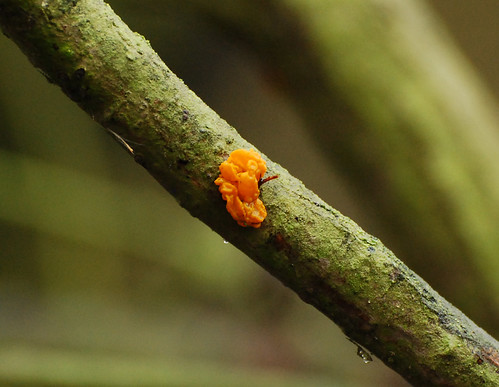
Dacrymyces chrysospermum – unfortunately I couldn’t find a common name for this resupinate fungus but its sumptuous colour against the green lichen on the tree stem is striking.
All in all Fen Drayton was a great venue for a Saturday morning wildlife adventure and I’ll be posting from here again before too long.
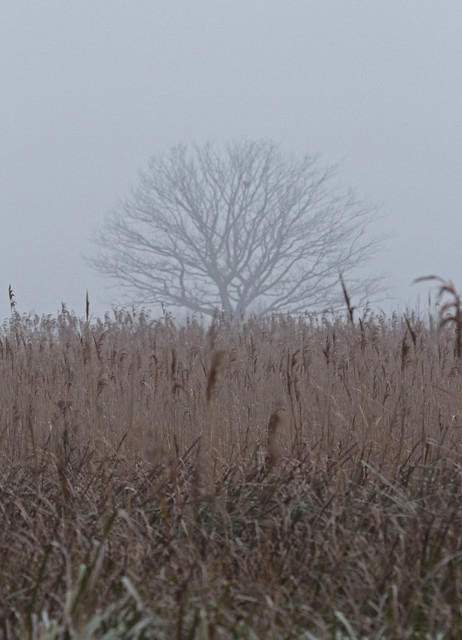 A distant tree across the reedbeds through the thick early morning mist
A distant tree across the reedbeds through the thick early morning mist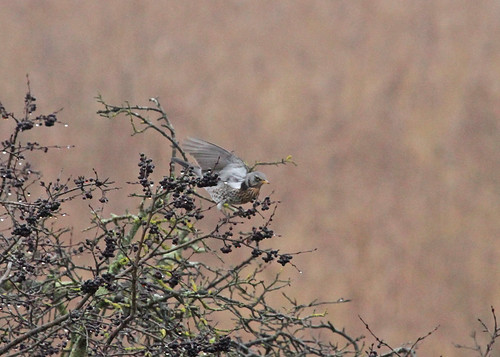 Fieldfare (Turdus pilaris, Dansk: sjagger)
Fieldfare (Turdus pilaris, Dansk: sjagger)  Redwing (Turdus iliacus, Dansk: vindrossel)
Redwing (Turdus iliacus, Dansk: vindrossel) A pale male bullfinch (Pyrrhula pyrrhula, Dansk: dompap)
A pale male bullfinch (Pyrrhula pyrrhula, Dansk: dompap)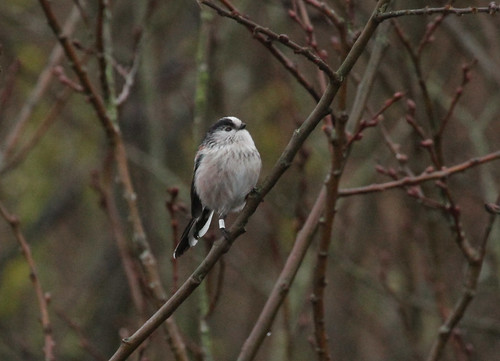 Long tailed tit (Aegithalos caudatus, Dansk: halemajse)
Long tailed tit (Aegithalos caudatus, Dansk: halemajse)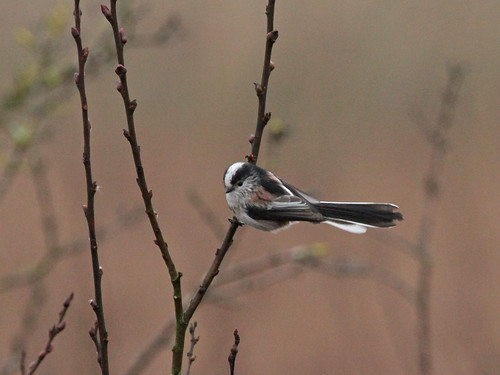
 A kestrel (Falco tinnunculus,Dansk: tårnfalk)
A kestrel (Falco tinnunculus,Dansk: tårnfalk)
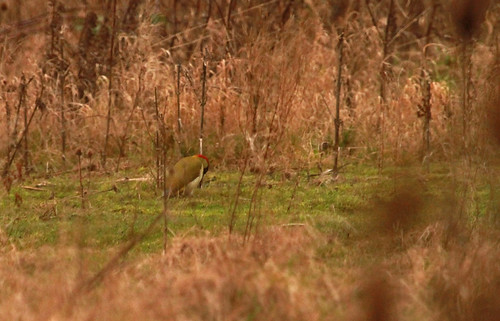 Green woodpecker (Picus viridis, Dansk: grønspætte) mining ants next to the car park at Fen Drayton lakes and fastidiously refusing to look up
Green woodpecker (Picus viridis, Dansk: grønspætte) mining ants next to the car park at Fen Drayton lakes and fastidiously refusing to look up Great spotted woodpecker (Dendrocops major, Dansk: stor flagspætte) patrolling the treetops
Great spotted woodpecker (Dendrocops major, Dansk: stor flagspætte) patrolling the treetops A small fraction of a much bigger flock of lapwing, I make it 84 in this group
A small fraction of a much bigger flock of lapwing, I make it 84 in this group A blue tit deftly plucking seeds from a swaying reed seedhead
A blue tit deftly plucking seeds from a swaying reed seedhead Goldeneye drake – elegance personified
Goldeneye drake – elegance personified
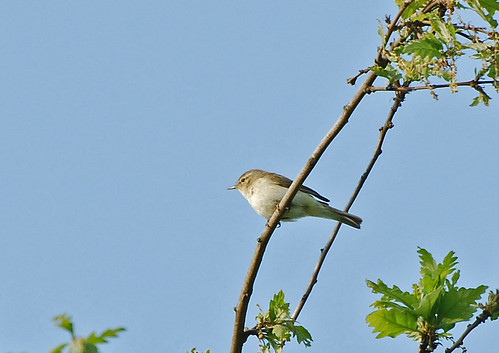








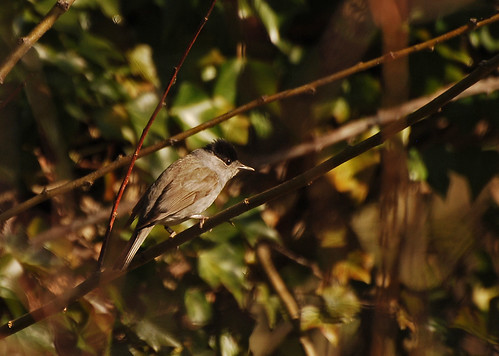










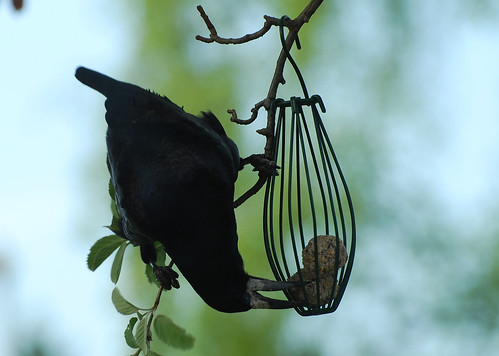











 One of the ‘Pump House’ barn owls from three years ago
One of the ‘Pump House’ barn owls from three years ago


 The glorious plumage of the starling!
The glorious plumage of the starling!







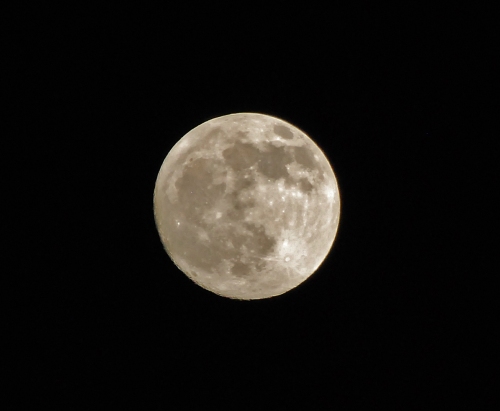
 A distant great spotted woodpecker – if only I could digiscope! This one wasn’t taken on Saturday… but it was at Milton Country Park
A distant great spotted woodpecker – if only I could digiscope! This one wasn’t taken on Saturday… but it was at Milton Country Park One of six mute swan cygnets
One of six mute swan cygnets





